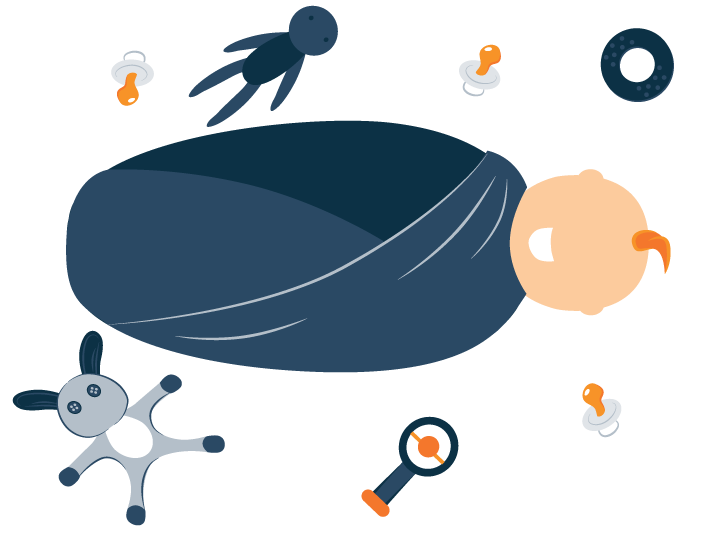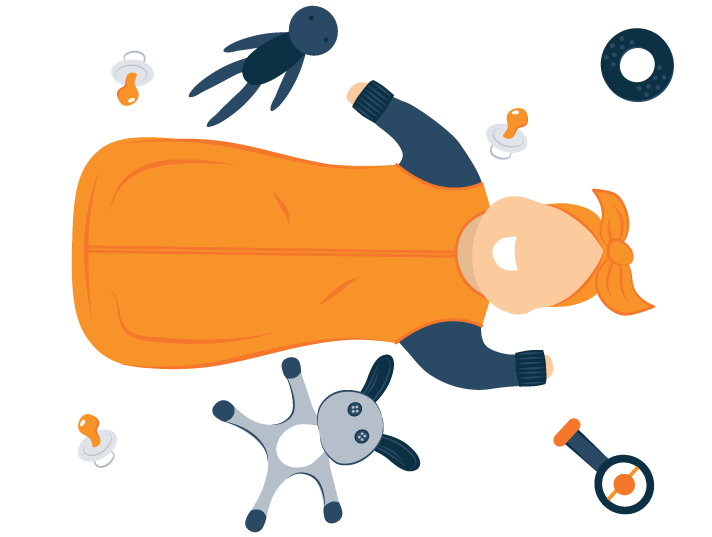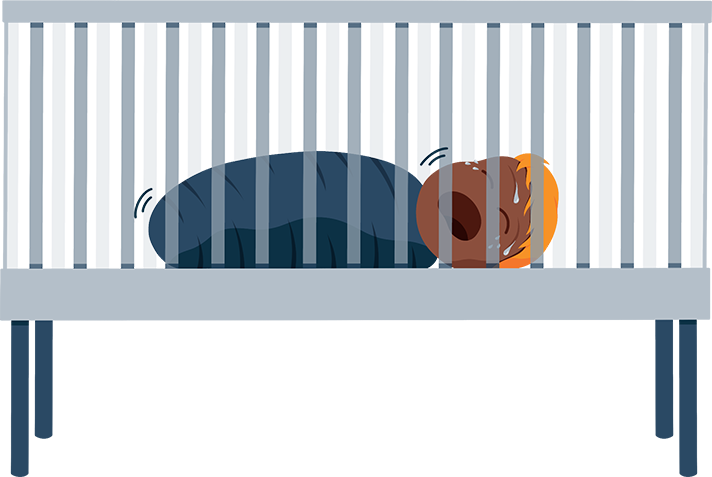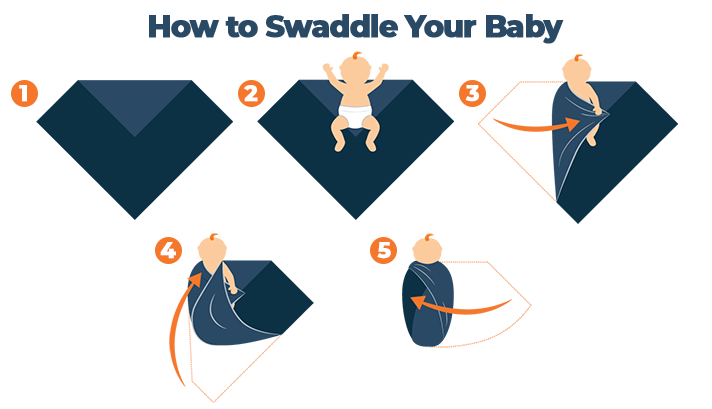It seems like everybody has different advice about parenting, doesn’t it? In one conversation, a seasoned mom will tell you one thing, and the next person you talk to will say something that totally contradicts it. So who’s right?
The answer to the question might be both or neither. When it comes to being a good parent, it’s helpful to remember that all babies are different, and when it comes to swaddling, the debates can be even more intense. New parents often ask what the difference is between using a sleep sack vs. a swaddle.
Keep reading to learn more about the differences between the two so you can make the right choice for your baby.
What Are Swaddles?
What Are Swaddles?
A swaddle is a thin blanket used to wrap up your little one like a burrito. Swaddles simulate the womb experience by keeping your infant snug.
They’re also helpful for parents who wish to minimize the waking effects of the Moro reflex. This automatic reflex occurs in infants as they adjust to all of their new stimuli, and it’s often a twitch or jerk that causes the baby to throw their hands in the air. Swaddling helps to suppress this reflex, allowing your newborn to sleep longer and more soundly.
View Our Full Guide: Top Rated Swaddle Blankets
What Are Sleep Sacks?
What Are Sleep Sacks?
A sleep sack is a wearable blanket that may also have features allowing it to be used as a swaddle. In most cases, the hands and arms are free and the baby’s torso, legs, and feet are housed in the sack. The American Academy of Pediatrics doesn’t recommend the use of blankets for babies because of the risk of Sudden Infant Death Syndrome (SIDS), so sleep sacks are a safer alternative to keep your little one cozy and warm.
They are helpful in keeping the baby warm and secure during the night. They are similar to a swaddle because they do keep the lower limbs snug, but they’re simpler to use, can be used for older babies, and are also easily modified for diaper changes.
Read Our Guide: Hightest Rated Sleep Sacks
Sleep Sacks vs. Swaddles – The Difference
The most obvious difference is that a swaddle is a blanket meant to entirely wrap the baby and restrict the movement of the arms and legs, while a sleep sack goes beyond a simple blanket. You could think of it like a pair of pajamas without legs. Instead, you put your little one in a bag with a zippered front and either sleeves or armholes.
Swaddles are meant for newborns and infants, but they shouldn’t be used after a baby can roll over on her own. The reason is that the restricted limb movement means that your child could suffocate if she/he rolls on the tummy.
Sleep sacks can be used up until toddler age (or even later). They allow the child to move their arms freely, though their legs are still somewhat confined.
There are also hybridized models. For example, there are swaddles that make it a breeze to re-wrap to allow the arms to be free. And, some versions have flaps that can be used to wrap your child’s arms.
How to Choose
Size
Swaddle blankets should be large enough to wrap your little one snugly. There are varying sizes that correspond to your baby’s weight and height. When your little one is still a newborn, a small receiving blanket may do the trick—but be prepared for them to outgrow it quickly.
As your baby gets stronger, they’re likely to jailbreak their swaddle blankets, and it could be time to graduate to a sack instead. Because these items have some structure, there are different sizes available based on age and weight. There are also one-size-fits-all solutions, but they might not have all the customization and adjustments that you need.
Comfort
Make sure you choose a soft fabric for your sleep sack or swaddle that is temperature appropriate. In the summer months, opt for lighter weight fabric and ensure that your baby isn’t too hot or cold. When it’s cold, choose something thicker and cozier, but be careful not to overheat your infant.
Some swaddles and sacks come with buttons, zippers, and Velcro. While these additions can make Mom and Dad’s job easier, check to be sure that these pieces aren’t coming into contact with baby’s skin or presenting any type of choking or scratching hazard.
Ease of Use
Middle-of-the-night diaper changes may make you reconsider the merits of swaddling your baby from scratch with a blanket. If you have an extra wiggly baby, then you may want something that’s easy to use. Many swaddle blankets have Velcro closures and guides to make swaddling in the dark an easier task.
And when it comes to sleep sacks, all you have to do is place your little one inside and zip from bottom to top.
Style
There are dozens, if not hundreds of patterns to choose from. Opt for plain to match everything or reflect your personality and style with adorable patterns like unicorns, rainbows, or sophisticated abstract prints. Many brands come in packs of three, so you have plenty of options to choose from.
Safety
As a parent, your top concern is safety. Whichever blanket style or material you choose, always make sure that your little one can breathe.
If they’re of rolling age, they should not have their arms confined in any way. And, of course, feel your baby’s skin at regular intervals to make sure they’re not too hot or cold.
As your little one grows beyond a couple of months of age, also check to make sure that their legs aren’t too tightly confined, which can cause hip dysplasia. Their legs and hips should be free to open up naturally.
Frequently Asked Questions
Which is better for newborns?
For newborns, a swaddle is likely to be your best bet. These most closely simulate the womb and keep the sleep-disrupting Moro reflex at bay.
Here’s a fun fact for you: according to author Dr. Harvey Kemp, babies actually need a fourth trimester in the womb. The only reason they don’t stay longer is that their head would grow too large to exit the birth canal. Therefore, simulating the womb as much as possible during the first three months of your newborn’s life should make their transition easier.
How to use swaddle blankets?
The swaddling procedure can seem intimidating, but it’s not hard to perfect your baby burrito-wrapping technique.
Follow along with this five-step process, and you could be a swaddling pro in no time!
- Lie the blanket on a flat surface and fold in half, making a diamond shape.
- Place your baby on his back with his shoulders just below the top fold. The pointed edge should be at his feet.
- Gently bend your baby’s right arm and place it on his chest. Grab the right side of the blanket and pull it across the body, tucking the edge underneath. Make sure the left arm is still free.
- Next, take the bottom of the blanket, fold it over his feet and tuck the edges into the top.
- Now, do the same thing with the left side as you did with the right. Bend your baby’s left arm and place it against his chest. Take the other side of the blanket, pull it across, and tuck in the edge. You did it!
Make sure that your baby’s hips can move and that the blanket isn’t too tight. Ideally, you want to be able to place two to three fingers between baby’s chest and the blanket.
*Swaddling can also be done with the arms straight by the side instead of bent.
Are sleep sacks safe for babies who can roll over?
Yes, they are, but with one caveat. Make sure that your baby’s arms are free, so they can maneuver themselves if they need to. Also, there shouldn’t be excess blankets, stuffed animals, or other items around that can pose a suffocation hazard.
When should babies stop wearing these?
The practice of swaddling should end as soon as a baby can roll over on her own. This age is different for everyone, but it typically starts around four to six months old. Some babies love to be swaddled, and you can continue to use them when your infant is 8 to 10 months old, but never leave them unsupervised or allow them to sleep in them at this age.
The sacks can be worn longer, and some parents even use them on their toddlers. As long as their feet and torso aren’t too warm, you can use the sacks for as long as your baby loves to wear it.
Is it safe for baby to sleep on tummy in a sleep sack?
The general recommendation is that babies should continue sleeping on their backs until they are able to roll over on their own. Even after this point, it is advised that parents continue to put their infant to sleep on their back and then if they roll over during the night on their own, this is fine. Allowing your child to sleep on their back as long as possible can help reduce the risk of SIDS (Sudden Infant Death Syndrome).
Conclusion
Most parents can agree that anything that helps their child to sleep safe and sound is worth a try. Both swaddles and sleep sacks can be safely used with babies to keep them cozy and warm as long as you follow the guidelines outlined in this article. Swaddling is generally best for infants under two months of age, while sleep sacks are a great blanket alternative for little ones from birth through toddlerhood.
Regardless of which you choose, remember that safety is more important than improving your baby’s sleep—but, both are possible! Remember to regularly monitor your baby for signs of overheating, and only use swaddles and sleep sacks that are the correct size for your baby’s age and stage of development.
Jill Zwarensteyn
Editor
About Author
Jill Zwarensteyn is the Editor for Sleep Advisor and a Certified Sleep Science Coach. She is enthusiastic about providing helpful and engaging information on all things sleep and wellness.
Combination Sleeper




